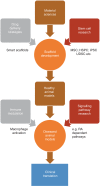Tissue engineering in pediatric urology - a critical appraisal
- PMID: 31579774
- PMCID: PMC6604568
- DOI: 10.1515/iss-2018-0011
Tissue engineering in pediatric urology - a critical appraisal
Abstract
Tissue engineering is defined as the combination of biomaterials and bioengineering principles together with cell transplantation or directed growth of host cells to develop a biological replacement tissue or organ that can be a substitute for normal tissue both in structure and function. Despite early promising preclinical studies, clinical translation of tissue engineering in pediatric urology into humans has been unsuccessful both for cell-seeded and acellular scaffolds. This can be ascribed to various factors, including the use of only non-diseased models that inaccurately describe the structural and functional modifications of diseased tissue. The paper addresses potential future strategies to overcome the limitations experienced in clinical applications so far. This includes the use of stem cells of various origins (mesenchymal stem cells, hematopoietic stem/progenitor cells, urine-derived stem cells, and progenitor cells of the urothelium) as well as the need for a deeper understanding of signaling pathways and directing tissue ingrowth and differentiation through the concept of dynamic reciprocity. The development of smart scaffolds that release trophic factors in a set and timely manner will probably improve regeneration. Modulation of innate immune response as a major contributor to tissue regeneration outcome is also addressed. It is unlikely that only one of these strategies alone will lead to clinically applicable tissue engineering strategies in pediatric urology. In the meanwhile, the fundamental new insights into regenerative processes already obtained in the attempts of tissue engineering of the lower urogenital tract remain our greatest gain.
Keywords: bladder exstrophy; low-compliance bladder; regenerative medicine; spina bifida; stem cells; tissue engineering; tissue remodeling.
©2018 Schäfer F., Stehr M., published by De Gruyter, Berlin/Boston.
Figures
References
-
- Kispal Z, Balogh D, Erdei O, Kehl D, Juhasz Z, Vastyan AM, et al. Complications after bladder augmentation or substitution in children: a prospective study of 86 patients. BJU Int 2011;108:282–9. - PubMed
- Kispal Z, Balogh D, Erdei O, Kehl D, Juhasz Z, Vastyan AM. et al. Complications after bladder augmentation or substitution in children: a prospective study of 86 patients. BJU Int. 2011;108:282–9. - PubMed
-
- Obermayr F, Szavay P, Schaefer J, Fuchs J. Outcome of augmentation cystoplasty and bladder substitution in a pediatric age group. Eur J Pediatr Surg 2011;21:116–9. - PubMed
- Obermayr F, Szavay P, Schaefer J, Fuchs J. Outcome of augmentation cystoplasty and bladder substitution in a pediatric age group. Eur J Pediatr Surg. 2011;21:116–9. - PubMed
Publication types
LinkOut - more resources
Full Text Sources

